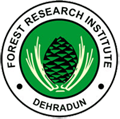
Chandigarh Forest Flora
A Comprehensive Database of Ligneous Plants of Chandigarh (India)
Designed & Developed by Bioinformatics Centre, Forest Research Institute, Dehradun



| Family: Papilionaceae | Genus: Erythrina | Species: Erythrina variegata Linn. |
Habit |
Leaf |
Flower |
Fruit |
Bark |
| Synonym | Erythrina indica Lam., Erythrina divaricata DC., Erythrina carnea Blanco | Flower Color | Red - Pink |
| Common Name | Pangara, Tiger claw | Flower Type | Raceme |
| English / Trade Name | Indian Coral Tree, Lenten Tree | Flowering Period | Jan-March |
| Vernacular /Local Name | Pangara | Fruiting Period | April-June |
| Altitude | Upto 750 m | Fruit Type | Pod |
| Habit | Tree | Fruit Details | Fruit a cylindrical pod, green, turning black and wrinkly as they ripen, thin-walled and constricted around the seed |
| Habitat | The tree occurs in a wide range of soils frequently on deep alluvial loams, silts and clays | Bark Type | Smooth |
| Distribution | Native to India and Exotics Malaysia, Myanmar, Thailand | Bark Details | Bark smooth and green when young, exfoliating in papery flakes, becoming thick, corky and deeply fissured with age |
| Distribution in chandigarh | Chandigarh Botanical Garden and Nature Park | Origin | Native |
| Leaf Type | Compound | ||
| Leaf Arrangement | Alternate (leaves born singly along stem) | ||
| Leaf Shape | Trifoliate | ||
| Description of Species | Deciduous tree. Bark yellowish or greenish-grey, smooth, blaze yellow. Leaves trifoliate, alternate Stipules small, lateral.Rachis 17-2 cm.p etiolule 7-10 mm, stout, glabrous.Leaflet 10-13.5 × 8.5-12.5 cm, ovate, rhomboid or deltoid-ovate, base truncate or obtuse, apex acuminate, margin entire. Lateral nerves 4-7 pairs, pinnate. Flowers bisexual, bright red, in dense racemes. Calyx spathaceous, oblique, recurved. Petals 5, sessile, standard 6.5×2.5 cm,oblong, elliptic,apexobtuse. Stamens10 monadelphous. Ovary stipitate, inferior, pubescent,1-celled.Ovules many. Style curved, subulate at the apex. Stigma capitate. Fruit a pod 15-30.5 cm long, torulose, constricted between seeds, dehiscent, seeds 6-8. | Leaf Details | Leaves trifolate, alternate, bright emerald-gren, onlong petioles 6-15cm, rachis 5-30 cm long |
All rights reserved by Forest Research Institute, Dehradun